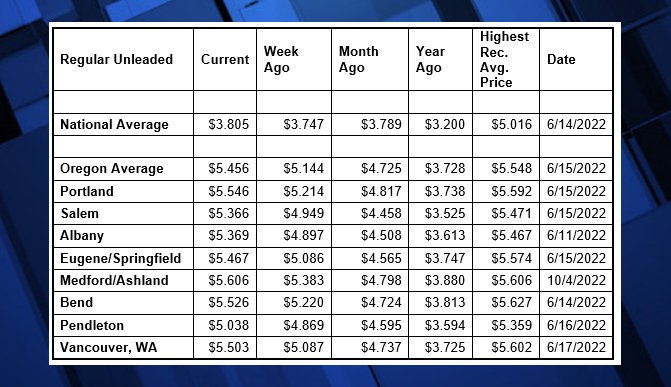California refinery outages push Oregon gas prices back toward record highs, AAA says

Oregon average jumps 31 cents after 50-cent rise prior week
PORTLAND, Ore. (KTVZ) – The West Coast is seeing the most extreme increase in gas prices in the country as several refineries in California undergo planned or unplanned maintenance, putting a severe crimp in supplies for the region, AAA Oregon/Idaho said Tuesday.
For the week, the national average for regular climbs six cents to $3.81 a gallon. The Oregon average leaps up 31 cents to $5.46. This is the fifth-largest weekly jump for a state in the nation.
“At least six refineries in California are offline or operating at reduced capacity, and there is limited pipeline supply to the West Coast. This has put a huge dent in supplies in this region, and gas prices are now again near the record highs we saw in mid-June,” says Marie Dodds, public affairs director for AAA Oregon/Idaho.
“This is refinery maintenance season, so it’s not unusual for refineries to be offline at this time of year. However, factor in the refineries that shut down unexpectedly with issues, and this creates a significant regional drop in gasoline supplies,” she added.
Most refineries in the U.S. are more than 50 years old. Some are more than 100 years old. All refineries have to undergo regular maintenance in order to keep running, the AAA spokeswoman says.
California has the toughest environmental standards in the nation for its fuel, so other refineries in other parts of the country were not able to ship product here. California Governor Gavin Newsom just eased the California requirements effective immediately, allowing the sale of winter blend fuel a month early. This fuel is not as environmentally friendly as summer blend but is less expensive to produce. Oregon and Washington also have stringent clean fuel standards.
The situation on the West Coast is also putting upward pressure on the national average. Both the national and Oregon averages hit record highs in mid-June, then declined for 14 consecutive weeks before rising again for the last two weeks. The national average reached its record high of $5.016 on June 14, while the Oregon average reached its record high of $5.548 on June 15.
“The regional differences in gas prices are extreme, with prices in the West Coast region above $5 a gallon in many areas and even above $6 in California. Meantime, Texas and other Gulf Coast states have prices dipping below $3 a gallon in some places,” added Dodds.
The Midwest has also seen gas prices surge due to a deadly refinery fire on Sept. 20 in Toledo, Ohio, which closed the plant. According to the latest reports, the 160,000 barrel-per-day BP-Husky Toledo refinery could be down for months.
Crude oil prices are lower than they were in June but have risen back above $80 per barrel this week as OPEC+ considers production cuts. Crude reached a recent high of $122.11 per barrel on June 8, and ranged from about $94 to $110 per barrel in July. In August, crude prices ranged between about $86 and $97. In September, crude prices ranged between about $76 and $88 per barrel. In late September, West Texas Intermediate fell below $80 per barrel for the first time since January.
Crude prices rose dramatically leading up to and in the first few months of Russia’s invasion of Ukraine. Russia is one of the world’s top oil producers and its involvement in a war causes market volatility, and sanctions imposed on Russia by the U.S. and other western nations resulted in tighter global oil supplies. Oil supplies were already tight around the world as demand for oil increased as pandemic restrictions eased. A year ago, crude was around $78 per barrel compared to $87 today.
Crude oil is the main ingredient in gasoline and diesel, so pump prices are impacted by crude prices on the global markets. On average, about 53% of what we pay for in a gallon of gasoline is for the price of crude oil, 12% is refining, 21% distribution and marketing, and 15% are taxes, according to the U.S. Energy Information Administration.
Demand for gasoline in the U.S. increased from 8.32 million b/d to 8.83 million b/d to last week. This is lower than last year at this time when demand was at 9.4 million b/d. Total domestic gasoline stocks decreased by 2.4 million bbl to 212.2 million bbl., according to the U.S. Energy Information Administration (EIA). If demand remains robust as supply tightens, drivers should brace for rising pump prices through the weekend.
Quick stats
Oregon is one of 17 states with higher prices now than a week ago, and 11 states, including Oregon, have double-digit increases. California (+53 cents) has the largest weekly jump in the nation. Oregon (+31) has the fifth-largest week-over-week jump. Florida (-21 cents) has the largest weekly decline. The average in Idaho is flat this week.
California ($6.41) has the most expensive gas in the country for the fourth week in a row and is the only state with an average above $6 a gallon. Six states, including Oregon, have averages at or above $5 a gallon. This week 13 states have averages at or above $4, and 37 states and the District of Columbia have averages in the $3-range.
The cheapest gas in the nation is in Mississippi ($3.06) and Texas ($3.10). For the 91st week in a row, no state has an average below $2 a gallon.
The difference between the most expensive and least expensive states is $3.35 which is extremely stark.
Oregon is one of 16 states with higher prices now than a month ago. The national average is two cents more and the Oregon average is 73 cents more than a month ago. Oregon has the second-largest monthly increase in the nation. California (+$1.15 cents) has the largest month-over-month jump. Rhode Island (-51 cents) has the largest monthly drop.
All 50 states and the District of Columbia have higher prices now than a year ago. The national average is 61 cents more and the Oregon average is $1.73 more than a year ago. This is the second-largest yearly increase in the nation. California (+$2.00) has the biggest yearly increase. Connecticut (+6 cents) has the smallest year-over-year increase.
West Coast
The West Coast region continues to have the most expensive pump prices in the nation with all seven states in the top 10. This is typical for the West Coast, as this region tends to consistently have fairly tight supplies, consuming about as much gasoline as is produced. In addition, this region is located relatively far from parts of the country where oil drilling, production and refining occurs, so transportation costs are higher. And environmental programs in this region add to the cost of production, storage and distribution.
Current refinery issues in California have exacerbated the situation, creating extremely tight supplies and sending prices in this region skyrocketing.
| Rank | Region | Price on 10/4/22 | ||
| 1 | California | $6.41 | ||
| 2 | Nevada | $5.51 | ||
| 3 | Oregon | $5.46 | ||
| 4 | Alaska | $5.41 | ||
| 5 | Washington | $5.33 | ||
| 6 | Hawaii | $5.22 | ||
| 7 | Arizona | $4.50 | ||
| 8 | Idaho | $4.42 | ||
| 9 | Illinois | $4.21 | ||
| 10 | Michigan | $4.18 |
As mentioned above, California is the most expensive state for the fourth consecutive week with Nevada, Oregon, Alaska, Washington, Hawaii, and Arizona rounding out the top seven. Oregon is third most expensive for the second consecutive week.
Six of the seven states in the West Coast region are seeing large jumps this week. California (+53 cents) has the largest increase in the region and the country. Alaska (+53 cents), Nevada (+38 cents), Arizona (+32 cents), Oregon (+31 cents), and Washington (+31 cents) have the largest increases in the region and the nation. Hawaii (-2 cents) is the only state in the region with a week-over-week decline.
The refinery utilization rate on the West Coast rose from 81.4% to 82.3% for the week ending September 23. The rate has ranged between about 76% and 90% in the last year.
According to EIA’s latest weekly report, total gas stocks in the region decreased from 25.78 million bbl. to 24.92 million bbl.
Oil market dynamics
Crude prices decreased at the end of last week due to lingering market concerns that demand will decline if global economic growth stalls or decreases due to a recession. However, reports the Organization of the Petroleum Exporting Countries (OPEC) and its allies—including Russia—known as OPEC+ intend to announce collective oil production cuts at their next meeting tomorrow (October 5) in Vienna have sent crude prices higher this week. Additionally, according to the EIA’s latest weekly report, total domestic commercial crude inventories decreased slightly by 200,000 bbl to 430.6 million bbl.
At the close of Friday’s formal trading session, WTI decreased by $1.74 to settle at $79.49. At the close of Monday’s formal trading session, WTI jumped $4.14 to close at $83.63. Today crude is trading around $87, compared to $79 a week ago. Crude prices are about $8 more than a year ago.
Drivers can find current gas prices along their route with the free AAA Mobile app for iPhone, iPad and Android. The app can also be used to map a route, find discounts, book a hotel and access AAA roadside assistance. Learn more at AAA.com/mobile.



